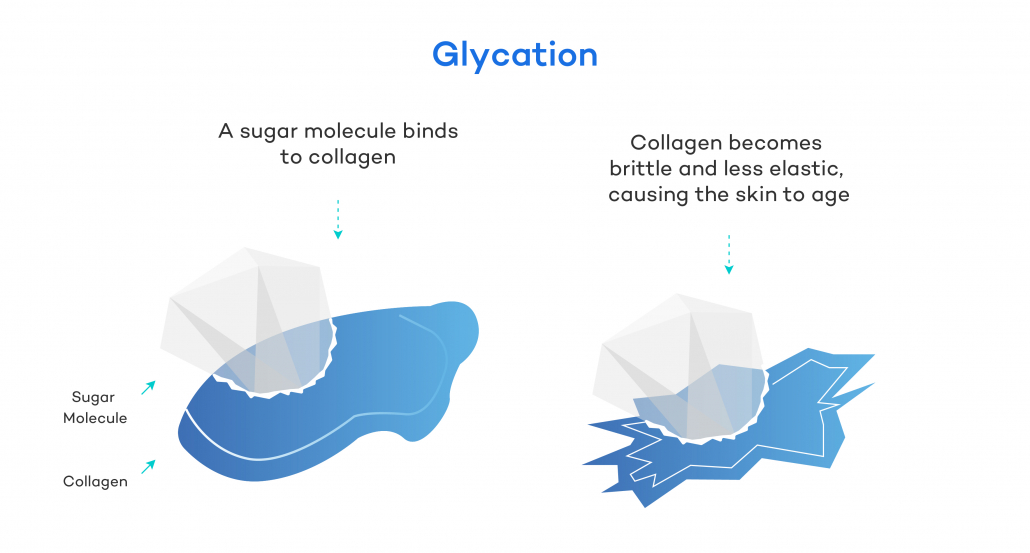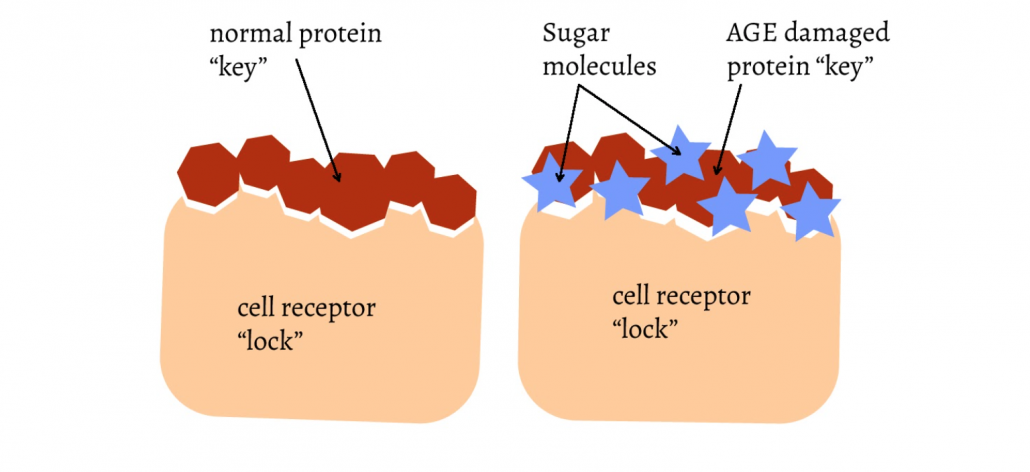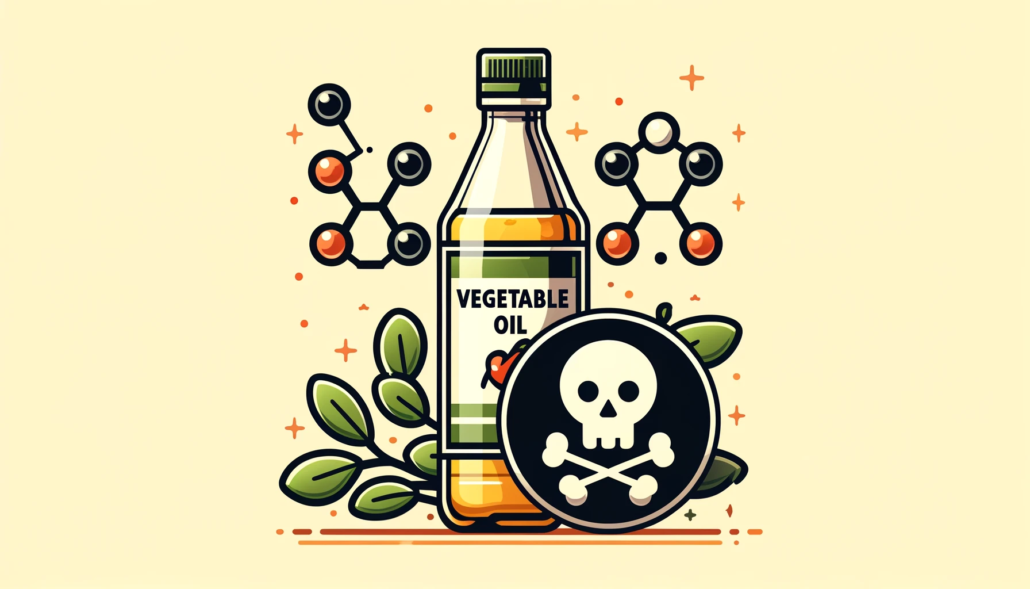We include products in articles we think are useful for our readers. If you buy products or services through links on our website, we may earn a small commission.
Glycation and AGEs: Everything You Need to Know

Table of Contents
- What is Glycation?
- What are advanced glycation end products (AGEs)?
- What Causes Advanced Glycation End Products?
- How do AGE’s Damage Body Tissues?
- Glycation and Inflammation
- Glycation and Heart Disease
- Glycation and Diabetes
- Glycation and Infertility
- Foods that Cause Glycation
- How Low Carb Diets Reduce Glycation
- The Bottom line on Glycation and AGEs
What is Glycation?
Glycation is a process in the body in which sugar molecules like glucose and fructose attach themselves to various types of protein and fat cells. This results in cellular structures that become sticky and brittle, with impaired function. These impaired molecules are called advanced glycation end products, or AGEs.
AGEs are significant factors in various human disease processes. Studies have linked excess AGEs in the body to diabetic complications, heart disease, and vascular damage, nerve injuries, loss of eyesight, and other metabolic damage.
Fast Facts
- Blood sugars (glucose, fructose) can stick to your cells and tissues and damage them, especially if blood sugar levels are higher than normal. This process is called glycation.
- As glycation levels rise, the body’s ability to repair the glycation fails and structures called advanced glycation end products, or AGEs are created, permanently injuring and deforming the affected cell or tissue.
- AGEs can bind themselves to cellular AGE Receptors (RAGE) and trigger high levels of oxidative stress, further damaging the affected cell and surrounding structures.
- In an environment of consistently high blood sugars, glycation, AGE accumulation AGE/RAGE interactions, and oxidative stress increase. Over time, this can set the stage for the development of many disease conditions, including diabetes, heart disease, and infertility.
- Consuming a high-carbohydrate diet is the main driving factor for out-of-control glycation and AGE accumulation in the body. High-fructose corn syrup, a common sweetener in processed foods is particularly damaging and causes a 1000% increase in glycation.
- By lowering carbohydrate intake and choosing to replace these calories with high-quality healthy fats and proteins, you can achieve normal blood sugar levels and likely avoid glycation-driven diabetes, heart disease, and infertility.
What are advanced glycation end products (AGEs)?
Advanced glycation end products are the result of chemical glycating reactions between chains of carbohydrates (sugars such as glucose or fructose) and various amino acids (protein molecules) within the body tissues and cells.
A chemical reaction between sugar and various amino acids eventually rearranges the structure of the affected protein, creating an AGE. These AGEs then bind themselves and further “crosslink” and damage other body proteins such as collagen or hemoglobin. Once AGEs are created and bound, they trigger inflammation and oxidation in the affected area.
Glycation differs from another common glycating process–where sugars attach to proteins and fats–called glycosylation. Glycosylation is an enzyme-directed site-specific process. This means it’s activated in a controlled way by the body, as opposed to the non-enzymatic chemical reaction of glycation.
AGEs and Oxidation
Oxidation is a process in which various chemically volatile molecules called reactive oxygen species (ROS) or “free radicals” are produced by our cells and tissues. These ROS often act as signaling molecules, and our cells have natural antioxidants to control them. However, if ROS are produced in large amounts, they can overwhelm the cell’s protective systems and cause injury to a variety of cellular structures and the tissues surrounding the cell.
AGE-RAGE Binding
AGEs can be both the cause and a product of oxidative stress. AGEs can bind to cell receptors called AGE receptors or RAGE. This AGE-RAGE binding interaction on the cell membrane triggers biochemical pathways within the cell that increase the level of ROS. The higher levels of free radical reactions result in oxidative injury to the cell and proinflammatory reactions from the immune system. As levels of oxidative stress increase, further glycating chemical reactions are triggered and more AGEs are formed.
Many studies show that an abundance of AGEs, the resulting RAGE binding, and high levels of oxidative stress are associated with an increase in inflammation and negative effects on various body systems.
Higher AGE levels are associated with many diseases and disorders including:
- Reduced immune system strength.
- Kidney failure.
- Eye damage, and other complications of diabetes.
- Metabolic diseases such as PCOS and insulin resistance.
Research also shows that the glycation-oxidation process is strongly associated with:
Another important effect of AGEs to note, especially in relation to Dr. Kiltz’s work, is the strong evidence that high AGE levels within the reproductive system can increase the risk of both female and male infertility.
What Causes Advanced Glycation End Products?
The types and numbers of AGEs in a person’s body depend on various internal factors such as blood sugar and insulin levels, age, and genetic factors. External influences such as the types and amounts of dietary carbohydrates consumed, cigarette smoking, and a sedentary lifestyle can also contribute to AGE creation in the body.
Carbohydrates, Glycation, and AGEs
Refined carbohydrate consumption and its resulting high blood sugars are strongly correlated to glycation levels and the creation of AGE molecules within the body. Simply put, the rate of glycation in the body increases as carbohydrate consumption and blood sugar levels rise.
Fructose, in the form of high-fructose corn syrup, a major ingredient in sweetened soft drinks and refined, processed foods, is particularly significant in AGE creation. Fructose is much more chemically reactive than the simple blood sugar glucose. Research has shown that fructose in the bloodstream increases glycation 10-fold more than glucose.
Cooking, Glycation, and AGEs
In early studies on glycation and AGEs, researchers focused on food preparation methods since glycation is what causes the Maillard reaction, a cooking term that explains why sugar turns into caramel when it is heated with cream. It’s also why ground beef “browns” when cooked in a hot skillet.
Researchers pointed to the abundance of grilled and broiled meats in the Western diet as a causative factor of AGE levels in the body, stating that the charring of these foods at high temperatures made them high in dietary AGEs (dAGEs) and that consuming these foods would increase body AGE levels.
Thankfully, however, recent research using more sophisticated measuring techniques has shown that the dAGE levels in grilled, roasted, and broiled meats are no worse, relatively speaking than other foods proposed to be healthier.
In fact, the newer research points to the intake of “healthy” foods such as apples, fruit juice, soy milk, whole-grain breads and skim milk as being associated with higher levels of AGEs within the body.
Fructose, Glycation, and AGEs
In fact, the newer research points to the intake of “healthy” foods such as apples, fruit juice, soy milk, whole grain breads and skim milk as being associated with higher levels of AGEs within the body.
As these high fructose foods are digested, fructose-associated AGEs are easily formed, and the resulting pro-inflammatory compounds are easily absorbed from the intestinal tract. This hypothesis has been aptly termed “fructositis” , indicating that AGE production is intestinally driven, not food-based.
In other words, it’s not those dietary AGEs in cooked meat one should worry about, but the AGEs being created internally due to a diet high in refined carbohydrates.
How do AGE’s Damage Body Tissues?
AGE’s damage body tissue by interfering with the normal functioning proteins, fats, and hormones.
AGEs and Protein
In the case of protein glycation, AGE’s cause structural damage to tissues. One of the hallmark ideas in biology is that “function follows form”, when applied to proteins this means that within the body proteins work in certain ways because they have specific physical forms.
You can imagine how certain keys fit certain locks. If you change the form of a key, it will no longer fit the lock that it was designed for. As a result, the key is no longer functional. In the same way, AGEs damage the physical structure of proteins in the body so that they no longer function properly when it comes to fitting with cells.

AGEs and Fat Cells
Most cell membranes are made up of various kinds of fats, including polyunsaturated fats (PUFA). PUFA are so-called because they have many unsaturated chemical bonds just waiting to react with the molecules around them. This unstable chemical makeup is particularly vulnerable to free radical activity.
Hence, as AGE levels accumulate around and within a cell, it can trigger an avalanche of free radicals which then react with the PUFA. The result is “lipid peroxidation”, a process in which the chemical bonds of the PUFA disintegrate. This damage then results in unstable cell membranes and cell dysfunction.
An example of this was shown in one study which found that AGEs interfered with cellular insulin sensitivity in fat cells via an increase in the free radicals within the cells.
AGEs and Insulin Resistance
The long-term effects of high blood sugar and glycation are also factors in the development of general insulin resistance in the body. Insulin is a hormone produced by the pancreas in response to the presence of glucose in the bloodstream.
The job of insulin is to push any glucose into our cells where it can be processed and used as an energy production molecule. However, if blood sugars are chronically high, the pancreas releases insulin almost constantly, bombarding cells with the message to take in more glucose.
Over time, cells develop a resistance to this insulin message, and sugar is left in the bloodstream. As blood sugar begins to rise, insulin production also increases. This circle of rising sugar and insulin ramps up glycation and AGE production and eventually this environment damages insulin signaling in the body.
Not surprisingly, research confirms that insulin resistance is highly correlated with heart disease, high blood sugar and diabetes and infertility.
All of this damage has serious implications for our overall health. Let’s look more closely at some specific health effects of glycation and AGE formation.
Glycation and Inflammation
As we’ve discussed above, the excessive glycation associated with a high carbohydrate intake and high blood sugar damages body tissues and cells. It is a vicious circle. The constant high blood sugars drive more AGE creation, which increases inflammation and oxidation, and this metabolic environment then creates more AGEs.
AGE molecules can bind to cellular AGE receptors (RAGE) and this event can trigger the immune system to release molecules which increase oxidative stress, amplify the inflammatory response, interfere with energy production in the affected cells, and damage the cell and nearby structures further. As you might imagine, inflammation is a strong marker for glycation damage and oxidative stress.
Glycation and Heart Disease
This circular spiral of high blood sugar, AGE creation, RAGE activation, and the resulting oxidation and inflammation is implicated in interfering with blood vessel health and the supply of blood to the heart.
It also explains why people with type 2 diabetes exhibit higher rates of heart disease. The AGE-RAGE interaction pathway interacts with our immune system and triggers the release of cells and signals which have downstream effects on the heart and vascular system.
AGEs are found in the arterial plaques of atherosclerosis, the well-known “hardening of the arteries”. When AGEs interact with RAGE, it can interfere with the suppleness of the blood vessels. The result is an increase in the stiffness of the blood vessels, which can lead to high blood pressure.
In addition, AGE-RAGE interactions bring the damage right to the wall of the blood vessels. Inflammation and oxidation damage the cells lining the blood vessels, making them vulnerable to lesions and calcium deposits that set the stage for dangerous blockages. There are many other negative cardiovascular effects being identified as more research is done.
Glycation and Diabetes
Diabetic complications are a direct result of high blood sugar which drives high rates of glycation, AGE accumulation, and increased oxidative stress in the body.
Various studies have shown that higher AGE levels are correlated with the loss of eyesight, due to tissue damage, chronic inflammation, and destruction of specific cells within the retina.
The kidneys are also prone to cellular AGE damage , and as a result, kidney disease and kidney failure are common diabetic complications.
AGE damage to the nerves in the lower extremities leads to peripheral neuropathy, a condition in which the hands or the feet and legs may suffer from extreme nerve pain, tingling, and numbness. This can result in undiscovered limb injuries and amputations. These complications are all linked by the cellular damage caused by AGE-RAGE interactions and oxidative stress within the affected body systems.
Glycation and Infertility
The reproductive system is yet another body system sensitive to high blood sugar and the associated process of glycation and the creation of AGEs.
Research confirms that elevated AGE levels, the AGE-RAGE interaction, and oxidative stress are associated with reduced ovarian function, granulosa cell dysfunction, and polycystic ovarian syndrome (PCOS).
A review of other studies in this area also reveals that AGEs and oxidative stress alter the activity of steroid production and follicular development in the ovaries of females, and causes damage to the capability of male testicles to produce normal sperm cells[13].
Female Infertility
Women are more prone to obesity for a variety of reasons, including lower muscle mass, metabolic rate, and hormonal shifts. Obesity can also contribute to infertility, along with the destructive effects of glycation, the AGE-RAGE interaction, and oxidative stress.
In the research literature, obesity is correlated with higher AGE levels and the disruption of the ovarian microenvironment, which can compromise oocyte performance and fertility.
It is worth noting that obesity, glycation, and insulin resistance are all factors with roles in metabolic dysfunction, and these conditions are rooted in the elevated blood sugar levels, high insulin levels, and insulin resistance associated with a high carbohydrate diet.
Glycation and PCOS
Polycystic Ovarian Syndrome (PCOS) is a disorder in which the affected woman’s menstruation and ovulation cycles and egg production are disrupted. PCOS is highly correlated with insulin resistance and obesity.
Women with PCOS also exhibit low-grade inflammation, and overproduction of male hormones, as a result of having high insulin levels. As many as 40% of women with PCOS also have insulin resistance, and many of these women are also overweight.
Not surprisingly, women with PCOS have elevated levels of AGEs and AGE receptors on ovarian tissues. Along with the other symptoms mentioned above, the AGE-RAGE factor contributes to the complications of PCOS, including reduced fertility and miscarriages.
Male Infertility
Male infertility is a single cause in about 30% and a factor in 40-50% of fertility cases , and contributing factors to this condition include glycation, AGE accumulation, RAGE interactions, and increases in oxidative stress within the male reproductive tract. Studies indicate that high AGE levels are associated with low sperm quality, testicular dysfunction, and erectile dysfunction.
Foods that Cause Glycation
As discussed above, much of the early research on glycation tried to lay the blame on high-heat cooking methods that cause Maillard reactions in broiled, grilled, or roasted meats. However, new research is now pointing to foods which have a high fructose-to-glucose ratio. This is because fructose is highly reactive and much more prone to glycation within the body than glucose. However, glucose is also implicated in glycation.
Many “healthy” foods recommended by dietitians fall into this higher fructose category. For example, one study points out that apples, soy milk, skim milk, cereal, whole grains, and other plant-based foods are culprits in elevated AGE levels in the body.
Other foods high in fructose including soft drinks, refined, processed carbohydrates, sweetened sauces, agave syrups, fruit juice, and products containing high-fructose corn syrup also cause higher AGE levels.
In addition, a diet generally high in carbohydrates can increase glycation because consuming carbohydrate-dense foods of any kind on a daily basis results in chronically higher blood sugars. While blood sugars are high, the rate of glycation will be elevated as well.
Foods high in carbohydrates include:
- Breads
- Crackers
- Pasta
- Sweets such as cake, pies, cookies and candies
- High starch vegetables such as potatoes, sweet potatoes and winter squashes
Basically, anything that tastes sweet and all plant foods will raise blood sugar and insulin and increase glycation and AGE creation.
In addition, the advice from the nutrition “experts” to eat 3 meals a day plus snacks contributes to glycation, because blood sugar and insulin are constantly being stimulated with food intake. Eating less frequently and practicing intermittent fasting, is another way to reduce glycation events within the body.
How Low Carb Diets Reduce Glycation
Excess glycation and AGE creation are a direct result of carbohydrate intake and the resulting high blood sugars. When carbohydrate intake is permanently reduced, blood sugar and insulin levels eventually return to a normal baseline. Lower blood sugar levels reduce the amount of internal glycation since there is less free-floating blood sugar to attach to body tissues.
The Bottom line on Glycation and AGEs
For most people, a high-carbohydrate diet causes chronically high blood sugar and insulin levels. The excess sugar contributes to higher rates of glycation and the formation of advanced glycation end products.
Once advanced glycation end product accumulation is higher than the body’s ability to break them down, a cycle of AGE-RAGE interaction, oxidative stress and inflammation begin.
This cycle damages many different body systems. We looked at diabetes, heart disease, and infertility but these are just some of the systems which can be damaged. AGEs are implicated in many other disease processes.
To reduce glycation and AGEs it’s critical to reduce the amount of carbohydrates, especially fructose-laden, refined carbohydrates in your diet. This will reduce blood sugar levels, calm insulin resistance, stop excess glycation and give your body a chance to dismantle and get rid of accumulated AGEs.
It’s that simple. Stop eating most carbohydrates and focus on consuming healthy fats and protein. You’ll feel better, your AGE levels will drop, and your body will thank you.





















